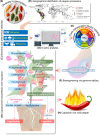Strategies to develop climate-resilient chili peppers: transcription factor optimization through genome editing
- PMID: 40526281
- PMCID: PMC12174194
- DOI: 10.1007/s00425-025-04747-5
Strategies to develop climate-resilient chili peppers: transcription factor optimization through genome editing
Abstract
Chili peppers (Capsicum spp.), a globally significant crop revered for their nutritional, economic, and cultural importance, are increasingly imperiled by the converging burdens of climate-induced abiotic stresses, including drought, heat, and salinity, and relentless biotic assaults from pathogens and insect herbivores. These overlapping stressors not only destabilize yield but also compromise the metabolic intricacy responsible for the accumulation of health-promoting secondary metabolites. Although Capsicum exhibits remarkable genetic and phytochemical diversity, the integrated transcriptional, metabolic, and epigenetic frameworks that underpin its stress resilience remain poorly delineated. This review synthesizes recent advances in decoding core transcription factor families, such as CaNAC, CaWRKY, and CaMYB, that serve as pivotal regulators of osmotic adjustment, reactive oxygen species detoxification, hormonal crosstalk, and secondary metabolite biosynthesis under stress conditions. We further highlight how multi-omics-guided gene discovery, when paired with CRISPR/Cas-mediated genome editing, enables precise reprogramming of key regulatory loci to enhance adaptive responses. Emerging innovations, including base editing, prime editing, and novel nucleases like Cas12a and Cas13d, are expanding the functional genome-editing landscape, while the integration of morphogenic regulators and genotype-independent transformation platforms is beginning to circumvent long-standing obstacles in Capsicum genetic engineering. Lastly, we propose a transformative framework that converges transcription factor modulation, multi-omics strategies, precision phenotyping, and next-generation genome editing to accelerate the development of climate-resilient Capsicum cultivars with optimized metabolic traits. This strategic convergence of molecular insight and biotechnological innovation offers a robust foundation for building next-generation chili pepper varieties capable of withstanding intensifying environmental and pathogenic pressures, ultimately safeguarding yield, nutritional quality, and agricultural sustainability in the face of global climate change.
Keywords: Capsicum stress tolerance; CRISPR/Cas9; Genome editing; Multi-omics; Transcription factors.
© 2025. The Author(s).
Conflict of interest statement
Declarations. Conflict of interest: All authors declare that they have no conflict of interest.
Figures


Similar articles
-
Evolution of agricultural biotechnology is the paradigm shift in crop resilience and development: a review.Front Plant Sci. 2025 Jun 19;16:1585826. doi: 10.3389/fpls.2025.1585826. eCollection 2025. Front Plant Sci. 2025. PMID: 40612601 Free PMC article. Review.
-
Harnessing CRISPR/Cas9 in engineering biotic stress immunity in crops.Planta. 2025 Jul 15;262(3):54. doi: 10.1007/s00425-025-04769-z. Planta. 2025. PMID: 40663257 Review.
-
Advancing crop disease resistance through genome editing: a promising approach for enhancing agricultural production.Front Genome Ed. 2024 Jun 26;6:1399051. doi: 10.3389/fgeed.2024.1399051. eCollection 2024. Front Genome Ed. 2024. PMID: 38988891 Free PMC article. Review.
-
CRISPR/Cas genome editing in soybean: challenges and new insights to overcome existing bottlenecks.J Adv Res. 2025 Jul;73:53-72. doi: 10.1016/j.jare.2024.08.024. Epub 2024 Aug 18. J Adv Res. 2025. PMID: 39163906 Free PMC article. Review.
-
Advancements in Water-Saving Strategies and Crop Adaptation to Drought: A Comprehensive Review.Physiol Plant. 2025 Jul-Aug;177(4):e70332. doi: 10.1111/ppl.70332. Physiol Plant. 2025. PMID: 40599019 Free PMC article. Review.
References
-
- Ahmad N, Nielsen BL, Mansoor S (2021) Editing the plastid genome of recalcitrant plant species. Trends Genet 37(11):955–957 - PubMed
-
- Ahmad S, Tang L, Shahzad R, Mawia AM, Rao GS, Jamil S, Wei C, Sheng Z, Shao G, Wei X (2021) CRISPR-based crop improvements: a way forward to achieve zero hunger. J Agric Food Chem 69(30):8307–8323 - PubMed
-
- Alfatih A, Wu J, Jan SU, Zhang ZS, Xia JQ, Xiang CB (2020) Loss of rice PARAQUAT TOLERANCE 3 confers enhanced resistance to abiotic stresses and increases grain yield in field. Plant Cell Environ 43(11):2743–2754 - PubMed
-
- Ali N, Singh S, Garg R (2025) Unlocking crops’ genetic potential: Advances in genome and epigenome editing of regulatory regions. Curr Opin Plant Biol 83:102669 - PubMed
Publication types
MeSH terms
Substances
LinkOut - more resources
Full Text Sources
Miscellaneous

